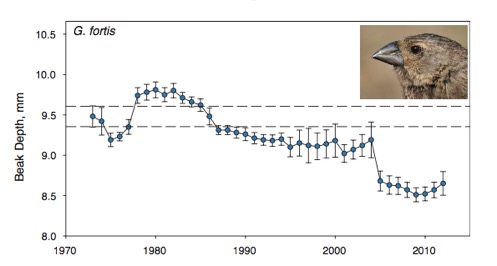Evolution in Darwin's Finches: Using Darwin's Theory of Evolution by Natural Selection postulates to evaluate evidence of evolution (Version 1.0)
By Kaitlin Bonner

Module Description:
In this activity students work with data sets collected by Peter and Rosemary Grant to investigate evidence for evolution in Geospiza fortis on Daphne Major, Galapagos. The first few minutes of the HHMI BioInteractive video “The Origin of Species: The Beak of the Finch” is used to introduce the activity. Students begin by discussing changes in beak size by evaluating a figure. Then they work through identifying what they would need to be convinced that this figure represents evolution in this population using the postulates of Darwin’s Theory of Evolution by Natural Selection. Each group works with a data set that addresses one of Darwin’s postulates using authentic research data collected by the Grants (available through Dryad Repository). Each group generates a figure and conclusion as to whether the postulate is supported by the data. The activity culminates with a discussion of the evidence presented by each group and a final open-ended exploration into the selective pressure that could be driving changes in average beak size over time in the population of finches.
Teaching Setting:
This activity was designed for a first year, introductory biology course for biology majors.
QUBES Citation:
Bonner, K. (2018). Evolution in Darwin's Finches: Using Darwin's Theory of Evolution by Natural Selection postulates to evaluate evidence of evolution. HHMI BioInteractive FMN (2017), QUBES Educational Resources. doi:10.25334/Q49988
|